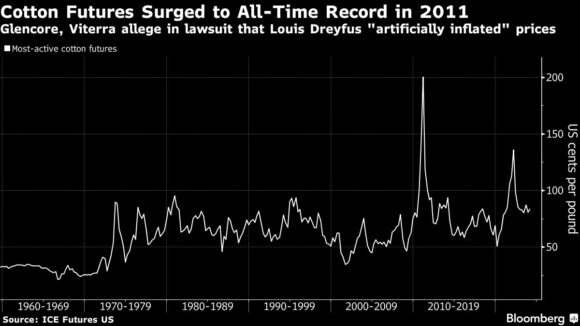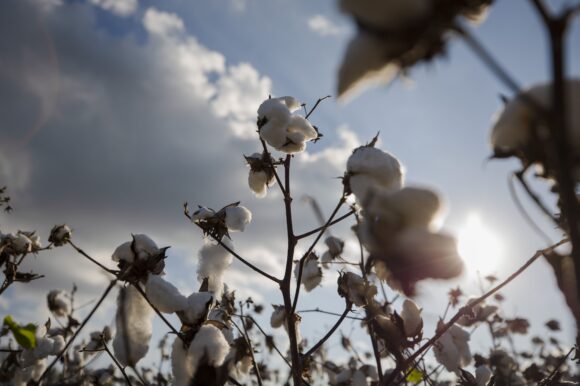Glencore Ltd. and Viterra BV have filed a lawsuit in New York claiming they lost more than $200 million from failed bets on cotton futures in 2011 because Louis Dreyfus Co. “manipulated and artificially inflated” prices.
The dispute is the latest in a legal fight that began more than a decade ago when traders accused Louis Dreyfus and its Allenberg unit of amassing huge positions in futures contracts to limit supply in the largest ever cotton market “squeeze,” when prices surged to a record. Two years ago, a US judge ruled the Dutch commodity trader must face an antitrust class action over the allegations.
Glencore and Viterra, two major commodity traders, were betting cotton prices would fall in 2011, holding big short positions in Intercontinental Exchange futures contracts for delivery in May and July, according to their Dec. 22 lawsuit. They claim Louis Dreyfus cornered the market, forcing Glencore and Viterra to buy contracts at a “much higher price than it could reasonably have been expected to be absent a squeeze” to close their positions.
 Louis Dreyfus and its US units “engaged in sustained uneconomic conduct in the cotton cash and futures market,” including taking “what was then the highest number” of deliveries of the commodity relative to stockpiles in exchange warehouses, Glencore and Viterra said. According to their suit, Louis Dreyfus accounted for more than 99% of all deliveries on the May 2011 contract.
Louis Dreyfus and its US units “engaged in sustained uneconomic conduct in the cotton cash and futures market,” including taking “what was then the highest number” of deliveries of the commodity relative to stockpiles in exchange warehouses, Glencore and Viterra said. According to their suit, Louis Dreyfus accounted for more than 99% of all deliveries on the May 2011 contract.
Rotterdam-based Louis Dreyfus declined to comment on the suit. In the earlier class-action litigation, the company denied wrongdoing and said there was no shortage of cotton in the market. The short-sellers were seeking to “shift the burden of their bad investment decisions,” which they knew carried the risk of losses, Louis Dreyfus said in a 2012 court filing.
ICE futures contracts are usually used to hedge or bet on prices without actual cotton changing hands. In 2011, Louis Dreyfus built a massive long position and “refused to liquidate,” choosing instead to take physical delivery, the suit alleged. That left short sellers unable to exit their bets except at “artificially inflated” prices, Glencore and Viterra said. Prices tripled from July 2010 to March 2011, touching a record of $2.197 a pound.
Cotton Futures Surged to All-Time Record in 2011 | Glencore, Viterra allege in lawsuit that Louis Dreyfus “artificially inflated” prices
Short-sellers typically sell futures contracts in a bet that they can buy them back when prices fall, pocketing the difference. Viterra had to cover 14,453 contracts at elevated prices, while Glencore covered 1,191 contracts, they said. Glencore also faced additional losses when making physical deliveries “solely because doing so was a less harmful option than covering the contracts,” according to the complaint.
Glencore and Viterra also alleged Louis Dreyfus didn’t need to take delivery of that much cotton and made “uneconomical” moves to further disrupt supplies and manipulate prices. Louis Dreyfus withdrew large amounts of cotton from exchange warehouses, even though lower-priced supplies were available on the cash market, according to the complaint.
But in a 2012 court filing, Louis Dreyfus dismissed that claim. “Buying cotton futures and taking delivery, even in significant quantities, is not manipulative,” the company said.
Glencore said it offered to sell the equivalent of 8,000 contracts worth of cotton. Each contract is for 50,000 pounds. But Allenberg Cotton Co., a Louis Dreyfus subsidiary, only purchased an amount equal to 222 contracts, according to the suit. Glencore claims the “token purchase” was an attempt to meet ICE requirements that companies with a net long position demonstrate their need for physical delivery, as opposed to getting cotton elsewhere.
“With 8,000 total contracts worth of cotton on offer, LDC chose not to buy any of that cotton, and instead forced sellers to deliver physical cotton to LDC — which was all but impossible at the time — or pay an artificially high price to close out their contracts,” according to the complaint.
Glencore and Viterra were originally part of an ongoing class-action lawsuit, but submitted notices in November to be excluded from that case. Glencore owns just under 50% of Viterra.
The original complaint was filed in 2012 by Mark Allen, the head cotton trader at Glencore from March to July 2011. Allen, who was trading futures both personally and on behalf of Glencore, alleged that he lost more than $57,000 on his personal transactions. A federal judge in Manhattan ruled in 2020 that Louis Dreyfus would have to stand trial, and subsequently declared the case an antitrust class action lawsuit in February 2022.
“A reasonable jury could infer the defendants acted with the purpose of influencing prices,” US District Judge Andrew L. Carter Jr. wrote in 2020.
The case is Glencore v. Louis Dreyfus, 23-cv-11125, US District Court, Southern District of New York (Manhattan).
Top photo: Cotton plants grow on a farm in South Carolina, U.S.
Was this article valuable?
Here are more articles you may enjoy.


 AccuWeather’s 2024 White Christmas Forecast Calls for Snow in More Areas
AccuWeather’s 2024 White Christmas Forecast Calls for Snow in More Areas  Nearly 1,000 Feared Dead After Cyclone Hits France’s Mayotte
Nearly 1,000 Feared Dead After Cyclone Hits France’s Mayotte  Mississippi High Court Tells USAA to Pay up in Hurricane Katrina Bad-Faith Claim
Mississippi High Court Tells USAA to Pay up in Hurricane Katrina Bad-Faith Claim  CVS Accused of Illegal Opioid Dispensing in Whistleblower Suit
CVS Accused of Illegal Opioid Dispensing in Whistleblower Suit 